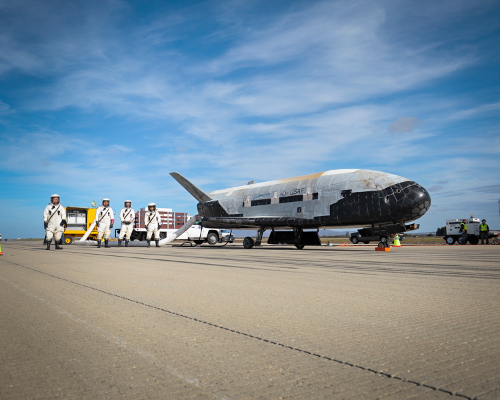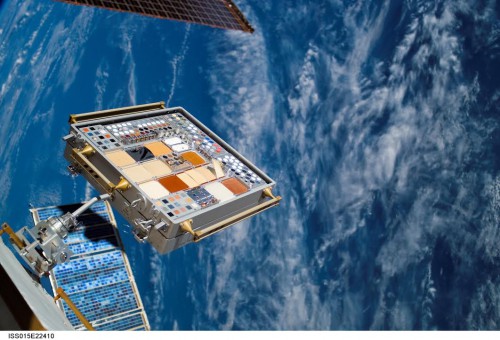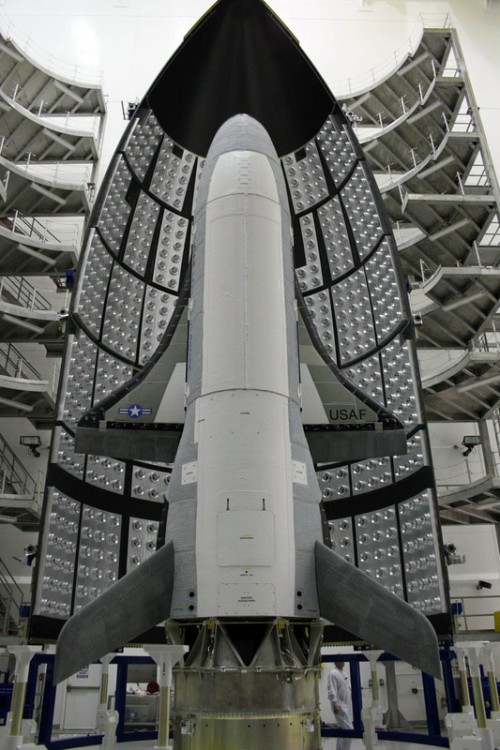
An advanced NASA materials science experiment like that flown on the International Space Station (ISS) for 13 years will be carried as a payload on board the U.S. Air Force X-37B winged reusable spaceplane, set for its fourth Atlas-V launch from Cape Canaveral Air Force Station, Fla., on May 20.
Called the Materials Exposure and Technology Innovation in Space (METIS) project, the investigation is planned to remain in space for at least 200 days.
By flying the METIS investigation on the X-37B, materials scientists will have the opportunity to expose nearly 100 different materials samples to the space environment, including some that flew earlier outside the ISS.
METIS is building on data acquired during the “Materials on International Space Station Experiment” (MISSE), which flew more than 4,000 samples in space from 2001 to 2013. Those samples were prepared and analyzed by more than 1,000 investigators from 85 different organizations in government, industry, and academia.

“By exposing materials to space and returning the samples to Earth, we gain valuable data about how the materials hold up in the environment in which they will have to operate,” said Miria Finckenor, the co-investigator on the MISSE experiment and principal investigator for METIS at NASA’s Marshall Space Flight Center in Huntsville, Ala.
“Spacecraft designers can use this information to choose the best material for specific applications, such as thermal protection on antennas or any other space hardware.”
“We have found a very wide variety of materials degradation and device performance” on materials flown in space for varying times according to another MISSE investigator, Kim de Groh, at the Glenn Research Center, Cleveland, Ohio. “When we refly materials we see the degradation rate change, comparing what we saw initially to what we find after additional exposures.”
She said the MISSE data shows that degradation rates are not consistent. Some materials continually get worse over time, while others “are not as bad as you might think,” depending on exposure.
NASA is flying some materials as part of METIS that also were tested during MISSE. Testing the same types of materials again can help scientists verify results obtained on the orbital outpost. If researchers see different results between the same type of materials used on both METIS and MISSE, it would help scientists learn about the differences experienced in various orbital environments.
“When we flew newly developed static-dissipative coatings on MISSE-2, we did not know they would be used for both the Curiosity rover and the SpaceX Dragon,” said Finckenor. “Some program we don’t know about now will be successful because engineers found the data they needed.”
The METIS experiment complements the station research, looking at a variety of materials of interest for use on spacecraft built by NASA, industry, and other government agencies. The materials flown in space are potential candidates to replace obsolescent materials with environmentally-friendly options.
Finckenor leads a diverse team of investigators from other NASA centers, aerospace companies, and universities. For both MISSE and METIS, the customers supply small quarter-size samples. METIS will fly a variety of materials including polymers, composites, and coatings. Finckenor has prepared the samples for flight and will helps with post-flight sample analysis.

“Data from the space station and METIS materials experiments will improve the lifetime and operations of future spacecraft needed for NASA’s journey to Mars,” said Lisa Watson-Morgan, Marshall’s chief engineer.
Marshall provided the hardware for the experiment, while the Air Force is providing NASA the opportunity to fly the experiment. The flight provides researchers an opportunity to collect additional data in advance of the next MISSE experiment aboard the space station in a couple of years.
The process for integrating the materials samples involved first installing circular, square and rectangular samples on an “experiment holder.”
The holder with the materials samples were then integrated with an experiment tray that can be fitted with several holders.
“We often use trays that have a series of openings for one-inch diameter samples,” said de Groh. “Imagine you have a piece of cling wrap from your kitchen, and you punch out a one-inch diameter disk. We then ask, ‘Will that survive for one year or more years in space?’ Probably not. So we stack layers of the material on top of each other and fly that stack in space.”

The trays were then integrated with a unit that appears like an open suitcase.
The fully integrated METIS unit has since been subjected to a vibration test to ensure that it can tolerate launch on an Atlas V. This was no problem since they were initially carried to the ISS on the space shuttle where they endured a much rougher ride.
The METIS units were then shipped from Marshall to the Kennedy Space Center where they were installed in the X-37B’s payload bay.
When used on the ISS, the MISSE boxes were installed by an astronaut during extra-vehicular activity. The suitcase devices were positioned on or near the ISS airlock for easy installation and removal.
It is likely the METIS mounting in the X-37B will be on a simple structure to elevate it out of the payload bay, although the Air Force was not able to confirm that because of the tight security surrounding X-37B missions.
The X-37B flight will provide researchers an opportunity to collect additional data in advance of the next MISSE experiment aboard the space station in a couple of years.
The MISSE and METIS data combined are expected to be extremely useful in designing future space systems and in MISSE’s case have already improved materials used in ground-based advanced technology systems like solar power systems and even art restoration techniques.
Among the spacecraft already making use of MISSE data are military and civilian Earth observation systems, military and civilian communications spacecraft, NASA lunar orbit spacecraft, the Hubble Space Telescope, the Curiosity Mars rover, and a NASA Glenn Atomic Oxygen Erosion Predictive Tool that helps in designing new spacecraft.
Some of the data has already had a dramatic impact on spacecraft operations.
“We flew several antenna coatings for the Aerospace Corporation and they used that for the Defense Meteorological Satellite Program (DMSP),” said Finckenor,
“The results that came from MISSE 7 made enough of a difference that they stripped off the coatings from their last two satellites to replace it with the new coating because it worked that much better.”
Finckenor did the pre-flight and post-flight measurements of the coating at Marshall. The coating, developed by a team led by Donald J. Boucher, principal engineer and scientist at Environmental Satellite Systems/Aerospace Corp. El Segundo, Calif., solved an antenna performance problem.
“We had coated our main reflectors with a material that turned out to be sensitive to water [vapor] over time. “We decided to remove the coating from all our remaining flight units and design a new coating that was very stable with respect to water.”
On April 3, 2014, an Atlas V rocket launched from Vandenberg AFB in California carried the DMSP-19 satellite into orbit. The DMSP-19 antenna employed the new, MISSE 7-tested coating.
“We were far less capable of describing vertical distribution of the moisture in the atmosphere with this old antenna coating,” said Boucher. “And now we are much, much more capable. We fixed an entire distribution issue with this new antenna coating. All of our satellites have this new reflector coating.”
All of the MISSE data now is now available online through the NASA MAPTIS Materials and Processes Technical Information System open to all legitimate users. The METIS data from the X-37B flight will eventually be available through this same system, NASA says.
Want to keep up-to-date with all things space? Be sure to “Like” AmericaSpace on Facebook and follow us on Twitter: @AmericaSpace
Missions » Air Force OTV » AFSPC-5 »




“If researchers see different results between the same type of materials used on both METIS and MISSE, it would help scientists learn about the differences experienced in various orbital environments.”
Since this unmanned vehicle can fly into the Van Allen belts and soak in lethal radiation indefinitely I guess that qualifies as “various.” Many of the experiments done on the space station to nowhere are nowhere near as effective as claimed because LEO is a very different radiation environment than outer space. This is almost never mentioned and instead LEO is mistakenly qualified as no different than being above the Van Allen belts or outside the magnetosphere.
“This was no problem since they were initially carried to the ISS on the space shuttle where they endured a much rougher ride.” I
How much “rougher”? I ask this because I am wary of solid rocket boosters being demonized after years of reading NewSpace advocates lying about them with such phrases as “1 in 25 explode” and calling on the divine von Braun. As SLS progresses this will come back into fashion despite over 200 in a row flawless firings of the 2.8 million pound thrust SRB’s. The simple steel casings of the shuttle SRB’s were reusable in a way that turbopump-fed liquid engines can never be. While the fans trash talk 30 years of SRB reuse SpaceX has yet to reuse a merlin or dragon capsule.
SRB’s are the solution to a powerful first stage and are derived from military ICBM technology. Because of a higher Isp and no toxic byproducts the better choice for the shuttle would have been pressure-fed “big dumb boosters” but lack of funding meant this solution was not, and never has been, pursued. A ocean-recovered big dumb booster in the 10 million pound thrust range, probably using methane and oxygen, is the missing piece of technology necessary for expanding the human presence into space. One reason I am highly critical of the these billionaire space hobbyists is that none of them are building such a booster.
NewSpace dogma has “the depot miracle” to supposedly make Super Heavy Lift unnecessary but such fabulous technology is probably not even practical- storing and transferring cryogenic propellents in space is more trouble than it is worth. Taking lego blocks and a couple gallons of gas at a time into Low Earth Orbit is a dead end.
“Since this unmanned vehicle can fly into the Van Allen belts”
Can it? Everything I’ve read on it so far describes it as having low earth orbit applications. Can it really handle the higher re-entry speeds needed to return from higher orbits?
“Can it really handle the higher re-entry speeds”
Classified I guess. But an elliptic orbit would take it well into all kinds of nasty radiation.